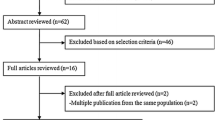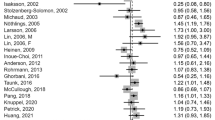Abstract
Objective: We studied whether polymorphisms in N-acetyltransferase 1 and 2 and Glutathione S-transferase M1 and T1 genes modify the association between meat consumption and breast cancer.
Methods: A nested case control was conducted in a Dutch prospective cohort. Breast cancer cases (229) and controls (264) were frequency matched on age, town and menopausal status.
Results: There is no relation between any type of meat consumption (i.e., total meat, processed meat, fresh meat, red meat and white meat) and breast cancer risk. Neither presence of NAT1 or NAT2 rapid genotype, or GSTT1 null genotype, alone or in combination with meat consumption affects breast cancer risk. Absence of GSTM1 shows 46% increased breast cancer risk (OR = 1.46 (95% confidence interval, 95% CI = 1.02–2.09)). When stratifying according to combined ‘GSTM1 genotype-meat consumption’ categories, breast cancer risk is slightly increased with consumption of red meat both in women with genotype GSTM1 presence (OR = 1.49 and 1.75 for intermediate and high versus low consumption) and in GSTM1 null genotype (OR = 1.18 and 1.02). These increases are statistically not significant. In postmenopausal women a suggestion of an effect of red meat consumption is observed: effects are slightly stronger, although still not statistically significant and without a clear dose–response relation: OR = 1.79 (95% CI = 0.92–3.50) and 1.46 (1.46 (95% CI = 0.76–2.82) for intermediate and high compared to low red meat consumption respectively. Reliable evaluation of interaction is not possible due to the small number of cancers.
Conclusion:GSTM1 null genotype increases breast cancer risk. Red meat consumption slightly increases breast cancer risk, but the relation is not statistically significant and GSTM1, NAT1, NAT2 and GSTT1 polymorphisms do not modify this relation.
Similar content being viewed by others
References
Missmer SA, Smith-Warner SA, Spiegelman D, et al. (2002) Meat and dairy food consumption and breast cancer: a pooled analysis of cohort studies. Int J Epidemiol 31: 78–85.
Layton DW, Bogen KT, Knize MG, Hatch FT, Johnson VM, Felton JS (1995) Cancer risk of heterocyclic amines in cooked foods: an analysis and implications for research. Carcinogenesis 16: 39–52.
De Stefani E, Ronco A, Mendilaharsu M, Guidobono M, Deneo-Pellegrini H (1997) Meat intake, heterocyclic amines, and risk of breast cancer: a case-control study in Uruguay. Cancer Epidemiol Biomarkers Prev 6: 573–581.
Knekt P, Steineck G, Jarvinen R, Hakulinen T, Aromaa A (1994) Intake of fried meat and risk of cancer: a follow-up study in Finland. Int J Cancer 59: 756–760.
Zheng W, Gustafson DR, Sinha R, et al. (1998) Well-done meat intake and the risk of breast cancer. J Natl Cancer Inst 90: 1724–1729.
Iscovich JM, Iscovich RB, Howe G, Shiboski S, Kaldor JM (1989) A case-control study of diet and breast cancer in Argentina. Int J Cancer 44: 770–776.
Nagao M, Ushijima T, Wakabayashi K, et al. (1994) Dietary carcinogens and mammary carcinogenesis. Induction of rat mammary carcinomas by administration of heterocyclic amines in cooked foods. Cancer 74: 1063–1069.
Williams JA, Phillips DH (2000) Mammary expression of xenobiotic metabolizing enzymes and their potential role in breast cancer. Cancer Res 60: 4667–4677.
Lightfoot TJ, Coxhead JM, Cupid BC, Nicholson S, Garner RC (2000) Analysis of DNA adducts by accelerator mass spectrometry in human breast tissue after administration of 2-amino-1-methyl-6-phenylimidazo[4,5-b]pyridine and benzo[a]pyrene. Mutat Res 472: 119–127.
Gorlewska-Roberts K, Green B, Fares M, Ambrosone CB, Kadlubar FF (2002) Carcinogen-DNA adducts in human breast epithelial cells. Environ Mol Mutagen 39: 184–192.
Hein DW, Ferguson RJ, Doll MA, Rustan TD, Gray K (1994) Molecular genetics of human polymorphic N-acetyltransferase: enzymatic analysis of 15 recombinant wild-type, mutant, and chimeric NAT2 allozymes. Hum Mol Genet 3: 729–734.
Hein DW, Doll MA, Fretland AJ, et al. (2000) Molecular genetics and epidemiology of the NAT1 and NAT2 acetylation polymorphisms. Cancer Epidemiol Biomarkers Prev 9: 29–42.
Krajinovic M, Ghadirian P, Richer C, et al. (2001) Genetic susceptibility to breast cancer in French-Canadians: role of carcinogen-metabolizing enzymes and gene-environment interactions. Int J Cancer 92: 220–225.
Deitz AC, Zheng W, Le. MA, et al. (2000) N-Acetyltransferase-2 genetic polymorphism, well-done meat intake, and breast cancer risk among postmenopausal women. Cancer Epidemiol Biomarkers Prev 9: 905–910.
Gertig DM, Hankinson SE, Hough H, et al. (1999) N-acetyltransferase 2 genotypes, meat intake and breast cancer risk. Int J Cancer 80: 13–17.
Huang CS, Chern HD, Shen CY, Hsu SM, Chang KJ (1999) Association between N-acetyltransferase 2 (NAT2) genetic polymorphism and development of breast cancer in post-menopausal Chinese women in Taiwan, an area of great increase in breast cancer incidence. Int J Cancer 82: 175–179.
Delfino RJ, Sinha R, Smith C, et al. (2000) Breast cancer, heterocyclic aromatic amines from meat and N-acetyltransferase 2 genotype. Carcinogenesis 21: 607–615.
Zheng W, Deitz AC, Campbell DR, et al. (1999) N-acetyltransferase 1 genetic polymorphism, cigarette smoking, well-done meat intake, and breast cancer risk. Cancer Epidemiol Biomarkers Prev 8: 233–239.
Ambrosone CB, Freudenheim JL, Sinha R, et al. (1998) Breast cancer risk, meat consumption and N-acetyltransferase (NAT2) genetic polymorphisms. Int J Cancer 75: 825–830.
Rundle A, Tang D, Zhou J, Cho S, Perera F (2000) The association between glutathione S-transferase M1 genotype and polycyclic aromatic hydrocarbon-DNA adducts in breast tissue. Cancer Epidemiol Biomarkers Prev 9: 1079–1085.
Rundle A, Tang D, Hibshoosh H, et al. (2002) Molecular epidemiologic studies of polycyclic aromatic hydrocarbon-DNA adducts and breast cancer. Environ Mol Mutagen 39: 201–207.
Seidegard J, Vorachek WR, Pero RW, Pearson WR (1988) Hereditary differences in the expression of the human glutathione transferase active on trans-stilbene oxide are due to a gene deletion. Proc Natl Acad Sci USA 85: 7293–7297.
Verschuren WMM, van Leer EM, Blokstra A, et al. (1993) Cardiovascular disease risk factors in The Netherlands. Neth J Cardiol 6: 205–210.
de Winter GA, Coebergh JWW, van Leeuwen FE, Schouten LJ (1990) Incidence of cancer in The Netherlands 1989. First report of the Netherlands Cancer Registry. Utrecht: Hoonte-Holland b.v.
Van den Brandt PA, Schouten LJ, Goldbohm RA, Dorant E, Hunen PM (1990) Development of a record linkage protocol for use in the Dutch Cancer Registry for Epidemiological Research. Int J Epidemiol 19: 553–558.
Bloemberg BPM (1993) On the effect of measurement error in nutritional epidemiology using dietary history and food frequency methodology. Thesis, University of Leiden.
Donders-Engelen MR, Heijden van der L, Hulshof KFAM (1997) Maten, gewichten en codenummers 1997. Wageningen, Land-bouwuniversiteit, Zeist, TNO.
NEVO. Nederlands Voedingssto.enbestand 1993 (1993) Den Haag, The Netherlands.
Doll MA, Hein DW (2001) Comprehensive Human NAT2 Genotype Method Using Single Nucleotide Polymorphism-Specific Polymerase Chain Reaction Primers and Fluorogenic Probes. Anal Biochem 288: 106–108.
Chen CL, Liu Q, Relling MV (1996) Simultaneous characterization of glutathione S-transferase M1 and T1 polymorphisms by polymerase chain reaction in American whites and blacks. Pharmacogenetics 6: 187–191.
Bell DA, Badawi AF, Lang NP, Ilett KF, Kadlubar FF, Hirvonen A (1995) Polymorphism in the N-acetyltransferase 1 (NAT1) polyadenylation signal: association of NAT1*10 allele with higher N-acetylation activity in bladder and colon tissue. Cancer Res 55: 5226–5229.
Bruhn C, Brockmoller J, Cascorbi I, Roots I, Borchert HH (1999) Correlation between genotype and phenotype of the human arylamine N-acetyltransferase type 1 (NAT1). Biochem Pharmacol 58: 1759–1764.
Payton MA, Sim E (1998) Genotyping human arylamine N-acetyltransferase type 1 (NAT1): the identification of two novel allelic variants. Biochem Pharmacol 55: 361–366.
Butcher NJ, Ilett KF, Minchin RF (1998) Functional polymorphism of the human arylamine N-acetyltransferase type 1 gene caused by C190T and G560A mutations. Pharmacogenetics 8: 67–72.
Smelt VA, Mardon HJ, Sim E (1998) Placental expression of arylamine N-acetyltransferases: evidence for linkage disequilibrium between NAT1*10 and NAT2*4 alleles of the two human arylamine N-acetyltransferase loci NAT1 and NAT2. Pharmacol Toxicol 83: 149–157.
www.louisville.edu/medschool/pharmacology/NAT.html.
Egan KM, Giovannucci E (1998) Dietary mutagens and the risk of breast cancer. J Natl Cancer Inst 90: 1687–1689.
Boyd NF, Stone J, Vogt KN, Connelly BS, Martin LJ, Minkin S (2003) Dietary fat and breast cancer risk revisited: a meta-analysis of the published literature. Br J Cancer 89: 1672–1685.
Author information
Authors and Affiliations
Corresponding author
Rights and permissions
About this article
Cite this article
van der Hel, O.L., Peeters, P.H., Hein, D.W. et al. GSTM1 Null Genotype, Red Meat Consumption and Breast Cancer Risk (The Netherlands). Cancer Causes Control 15, 295–303 (2004). https://doi.org/10.1023/B:CACO.0000024255.16305.f4
Issue Date:
DOI: https://doi.org/10.1023/B:CACO.0000024255.16305.f4




